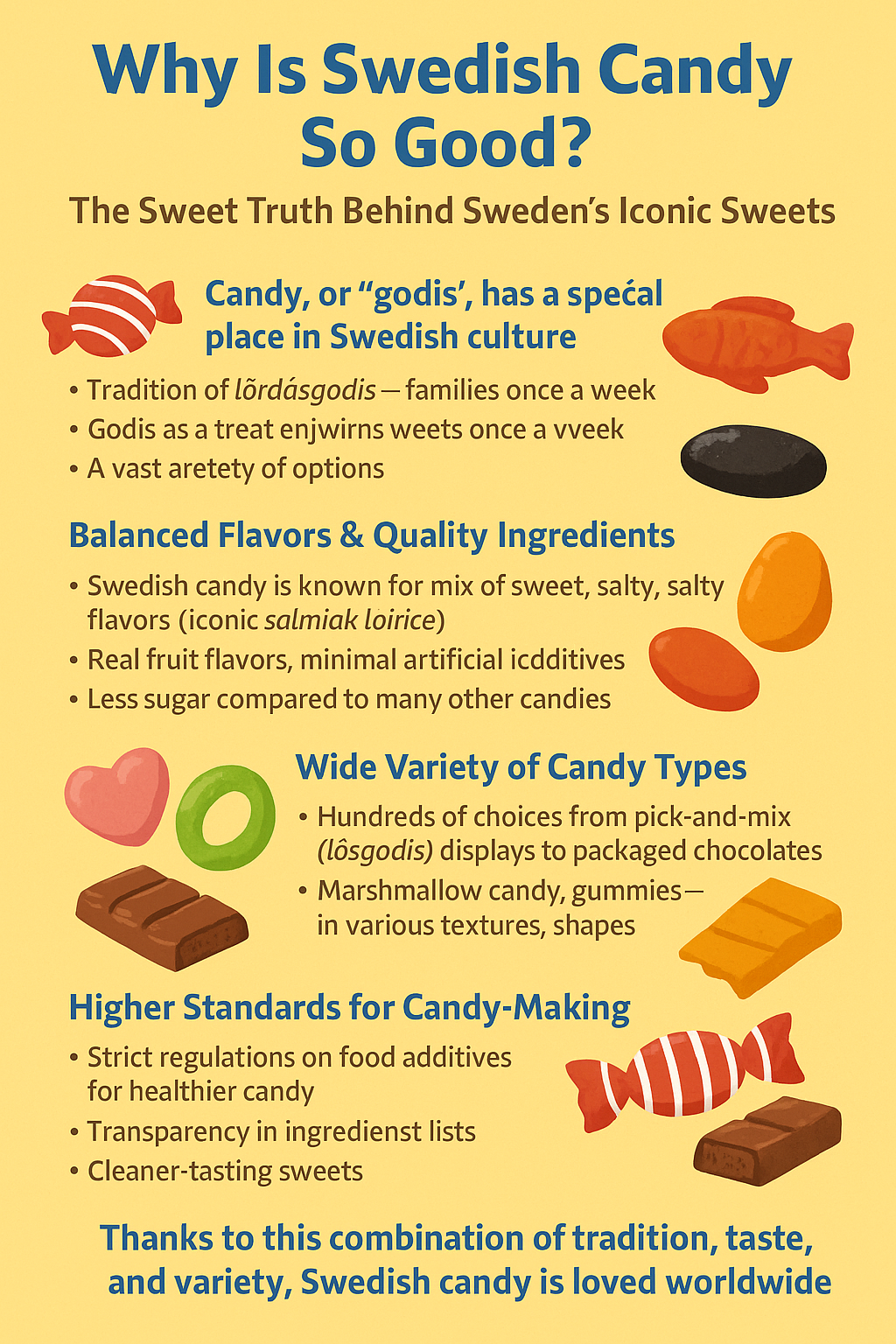If you’ve ever tried Swedish candy, you already know — it’s not your average sweet. From the salty tang of salmiak licorice to the fruity punch of Ahlgrens Bilar, Swedish candy has developed a cult-like following worldwide. But why is Swedish candy so good? The answer lies in a mix of history, tradition, science, and a little Nordic magic.
In this post, we’ll explore the factors that make Swedish sweets stand out — from pure ingredients to cultural candy habits — and why they’ve captured the hearts (and taste buds) of candy lovers across the globe.
A Sweet History: How Swedish Candy Became World-Class
Sweden’s candy culture dates back to the 19th century when sugar became more accessible to the average household. While other countries leaned heavily on chocolate, Sweden embraced a balance of sweet, sour, and salty candies.
In the 1950s, Sweden introduced the concept of “Lördagsgodis” — “Saturday candy” — a cultural tradition where children were allowed to indulge in sweets only on Saturdays. This habit created a nationwide appreciation for high-quality candy, as people savored it once a week rather than every day.
This tradition also encouraged variety, which is why Swedish candy aisles are full of gummies, hard candies, marshmallows, chocolate-covered treats, and salty licorice — often all in the same bag.
Quality Ingredients: Less Sugar, More Flavour
One of the biggest differences between Swedish candy and many mass-market sweets is ingredient quality. Swedish candy manufacturers tend to:
- Use natural flavours and colours from berries, fruits, and plants.
- Limit artificial additives compared to North American brands.
- Balance sweetness — many Swedish candies have less sugar, allowing flavours to shine.
For example, Malaco, one of Sweden’s biggest candy producers, focuses on real fruit juices and beet sugar rather than high-fructose corn syrup. The result? Candy that feels more like a flavour experience than just a sugar rush.
Variety Like Nowhere Else
When people ask why is Swedish candy so good, variety is a huge part of the answer. Sweden is famous for pick-and-mix candy walls (called lösgodis), where you can choose from hundreds of different types of candy by weight.
A single candy shop might have:
- Sweet gummies in every shape and fruit flavour imaginable.
- Sour belts dusted with tangy sugar.
- Foam candies like banana or strawberry marshmallows.
- Chocolate-covered marshmallow bites.
- Licorice — both sweet and salty — including the infamous salmiak.
This diversity of textures and tastes means there’s truly something for everyone, making Swedish candy universally appealing.
The Salty Licorice Phenomenon
If you’ve heard of Swedish candy, you’ve probably heard about salty licorice — and if you’ve tried it, you either love it or hate it.
Salty licorice (or salmiakki) is made with ammonium chloride, giving it a salty, umami punch that’s completely different from sweet licorice. In Sweden, this flavour is beloved, and the boldness of it shows Sweden’s fearless approach to flavour.
While it may not be for everyone, salty licorice has become a defining symbol of Swedish candy culture — something adventurous travelers always want to try.
Why Swedish Candy Stands Out Against Competitors
Compared to candies from other countries, Swedish candy holds an edge because of:
- Cultural respect for candy traditions (Lördagsgodis).
- Commitment to real ingredients.
- Innovative flavours — from sour foam fish to tangy blackcurrant gummies.
- Balanced sweetness — letting flavours shine without overwhelming sugar.
Even major candy companies in North America and Europe have started importing or imitating Swedish candy styles because the demand is so strong.
The Health Factor: Candy Without Guilt?
While candy isn’t exactly a health food, Swedish sweets tend to be less processed than many global competitors. This is thanks to:
- Lower sugar content.
- More natural flavourings.
- Fewer artificial dyes.
Swedish candy is about quality over quantity — a philosophy that fits into their larger cultural approach to food.
Global Popularity and Influence
In recent years, Swedish candy has become a hot trend worldwide, especially through:
- YouTube candy taste tests.
- Food travel bloggers praising lösgodis.
- Specialty snack stores carrying imported Swedish brands.
As social media shares videos of people trying Swedish sweets for the first time, the reputation continues to grow — boosting Sweden’s global candy authority.
How to Try Swedish Candy (Without a Trip to Sweden)
If you’re outside Sweden, you can still get authentic Swedish candy from specialty import stores or online snack retailers. Look for popular brands like:
- Malaco (gummies and licorice)
- Ahlgrens Bilar (foam car candies)
- Marabou (creamy Swedish chocolate)
- Kexchoklad (wafer chocolate bar)
For the ultimate experience, mix sweet, sour, fruity, and salty varieties in one bag — just like a real Swedish pick-and-mix.
Why Swedish Candy Is Here to Stay
Swedish candy’s charm is more than flavour — it’s about tradition, craftsmanship, and an unapologetic love for variety. While trends come and go, Sweden’s candy culture is so deeply rooted in its society that it’s unlikely to ever fade.
For candy lovers worldwide, Swedish sweets offer a taste that’s familiar yet unique — a perfect balance of old-world tradition and modern flavour innovation.
Conclusion: The Sweet Answer to “Why Is Swedish Candy So Good?”
From pure ingredients and innovative flavours to cultural traditions that encourage savouring candy rather than overindulging, Swedish sweets deliver an experience that’s hard to beat.
The next time someone asks why is Swedish candy so good, you’ll know the truth: it’s a combination of heritage, quality, and fearless flavour experimentation — and that’s exactly what keeps people coming back for more.

